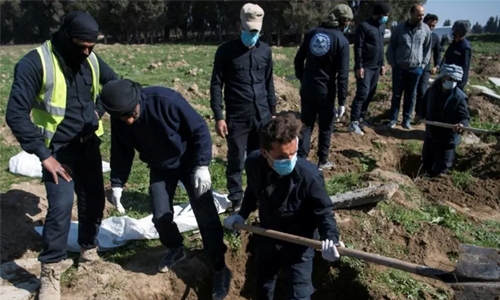Largest IS mass grave yet found outside Syria’s Raqa
Two feet deep, below a plot of farmland outside the Syrian city of Raqa, lies a large and deadly legacy of the Islamic State group: a mass grave holding an estimated 3,500 people. First responders learned of the burial site in the al-Fukheikha agricultural suburb last month, more than a year after US-backed forces captured Raqa from IS and as they closed in on the group’s final redoubt of Baghouz further south.
The belated discovery is the biggest example yet of how the violence IS sowed during the reign of its “caliphate” will be harvested for years to come, diggers and activists said. Several dozen mounds of dirt line one side of the al-Fukheikha plot, marking the more than 120 bodies already dug up by the Rapid Response Division of Raqa’s civil defence service. “These are individual graves, but behind us, by the trees, are the mass graves of those executed by Daesh (IS),” said Asaad Mohammad, the 56-year-old forensic assistant at the site.
“There are some 2,500-3,000 bodies estimated there, plus between 900 and 1,100 bodies in the individual graves, so at least 3,500 total,” he said. Eight other mass graves have already been identified around the northern Syrian city, including one nicknamed “Panorama,” from which more than 900 bodies had been exhumed. “Al-Fukheikha is the largest grave since IS came to Raqa” in 2014, said Mohammad.
‘Unidentified’
Earlier this week, diggers in flimsy medical masks excavated a small bundle wrapped in greying, damp cloth. They peeled away the fabric to reveal a decomposing body with a detached blackened jawbone, which Mohammad examined. “Estimated 35 years. Third-degree burns,” he said. Apart from his stoic partial-autopsy, the only sounds to be heard were the grating of hand shovels against the dirt, and the rustle of the wind through the nearby fir trees.
His colleagues carefully placed the bundle in a white tarpaulin body bag onto which Mohammad scrawled the date, location, and a word he has become accustomed to writing: “Unidentified.” By noon, his team of 10 had dug up eight bodies. Some had been dead so long there was little left of them, and the diggers had to weigh down the body bags with rocks to keep them from flying away in the wind.
They logged any identifying details into a ledger and loaded the bodies into a white pickup to be re-buried about 10 kilometres (six miles) away at a proper cemetery. It has become a macabre routine, said Mohammad -– one he was sure will eventually be played out again in Baghouz, the last speck of IS territory further south.
Missing foreigners
Since the Raqa division began its work in January 2018, it has exhumed more than 3,800 bodies, said the force’s supervisor Turki al-Ali. “We’ve heard accounts from residents of al-Fukheikha that they would see people gathering with someone in an orange suit,” said Ali, referring to the garb in which IS would typically dress its executed captives.
US journalist James Foley was wearing such a suit when he was killed, and analysts believe footage of his death indicates he may have been killed around Raqa. Another American captive, Kayla Mueller, is thought to have died near Raqa as well. Their bodies have never been recovered.
Related Posts

